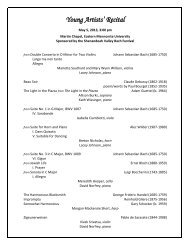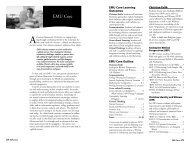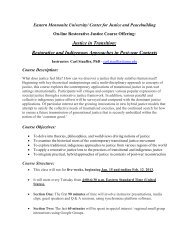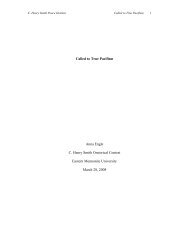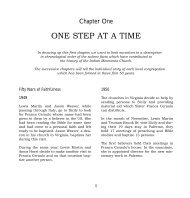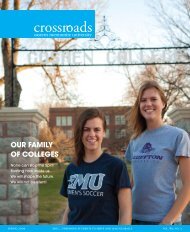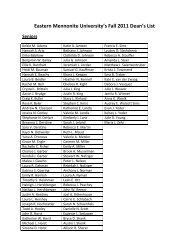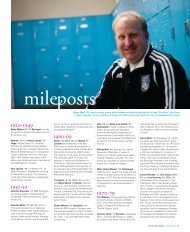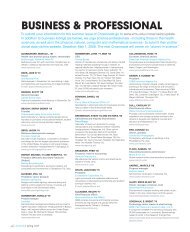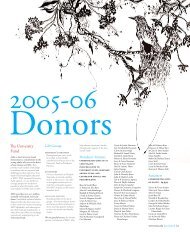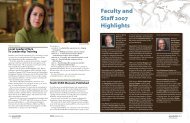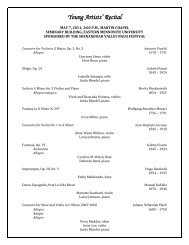Download the 2013-14 Suter Science Seminar schedule (PDF)
Download the 2013-14 Suter Science Seminar schedule (PDF)
Download the 2013-14 Suter Science Seminar schedule (PDF)
Create successful ePaper yourself
Turn your PDF publications into a flip-book with our unique Google optimized e-Paper software.
<strong>Suter</strong> <strong>Science</strong> <strong>Seminar</strong>s<br />
Students, faculty, staff and community<br />
persons are invited to attend!<br />
<strong>2013</strong>-<strong>14</strong><br />
<strong>Suter</strong> <strong>Science</strong> Center<br />
1194 Park Road<br />
Harrisonburg, Va. 22802<br />
540-432-4400<br />
emu.edu/science-seminars
<strong>Suter</strong> <strong>Science</strong> <strong>Seminar</strong>s<br />
These seminars/presentations are made possible by <strong>the</strong> sponsorship<br />
of <strong>the</strong> Daniel B. <strong>Suter</strong> Endowment in Biology. The seminar<br />
presentations are oriented toward undergraduate students in science<br />
and graduate students in biomedicine who make up <strong>the</strong> primary<br />
audience. Faculty, staff, and community persons are invited to<br />
participate in this seminar series. Come 15 minutes early before <strong>the</strong><br />
<strong>schedule</strong>d seminar time to meet <strong>the</strong> seminar speaker and join us for<br />
light refreshments.<br />
The Daniel B. <strong>Suter</strong> Endowment was named in honor of long-time<br />
Eastern Mennonite University (EMU) biology professor, Daniel B.<br />
<strong>Suter</strong>, who is now deceased. The endowment was established in 1986<br />
through <strong>the</strong> generous donations of alumni and friends and currently<br />
consists of over $1 million of invested funds.<br />
Endowment income is annually divided into three categories:<br />
faculty salary support through an endowed chair position,<br />
awarded to Dr. Roman J. Miller<br />
program portion that provides monies for <strong>the</strong>se seminars,<br />
supporting science faculty who are conducting collaborative<br />
research projects with students, and special projects<br />
several named scholarships, which are annually awarded to<br />
selected students majoring in biology and chemistry<br />
Persons interested in contributing to <strong>the</strong> Daniel B. <strong>Suter</strong><br />
Endowment are invited to contact:<br />
Kirk Shisler, Vice President for Advancement<br />
(540)432-4203<br />
kirk.shisler@emu.edu<br />
For more information on seminars contact:<br />
Dr. Roman Miller<br />
Daniel B. <strong>Suter</strong> Endowed Professor of Biology<br />
Director of <strong>the</strong> MA in Biomedicine Program<br />
(540)432-4412<br />
millerrj@emu.edu<br />
<strong>2013</strong>-<strong>14</strong> <strong>Seminar</strong> Schedule<br />
September:<br />
20 Maria Craig: Pursuing <strong>the</strong> Initiating Events of Lupus, Psoriasis, and Rheumatoid<br />
Arthritis: The Interaction Between <strong>the</strong> LL-37 Peptide and DNA............................................4<br />
30 Mike Barber: Paleoindians in Virginia: The Spatial and Temporal Quandary......................5<br />
October:<br />
12 John Wenger: Putting Health Back in Healthcare........................................................................6<br />
28 Virginia Bethune: Medical Benefits of Music ................................................................................7<br />
November:<br />
4 Daniel King: Ultrasound and <strong>the</strong> Dynamics of Tiny Shelled Bubbles...................................8<br />
11 Anneke DeLuycker: Into <strong>the</strong> Andes: The Cloud Monkeys of Peru..........................................9<br />
December:<br />
6 STEM Student Research Symposium.............................................................................................10<br />
January:<br />
13 Brian Augustine: A Circuitous Path Called Undergraduate<br />
Research in Materials <strong>Science</strong>..........................................................................................................11<br />
31 Patricia Slattum: Medications and <strong>the</strong> Aging Brain..................................................................12<br />
February:<br />
10 James Minick: The Blueberry Years.................................................................................................13<br />
21 Bernard Bowman: “Forty Years Post EMU: Reflections on<br />
an Unexpected Career”.......................................................................................................................<strong>14</strong><br />
March:<br />
17 Randall Collins: Forensic Application of Optical Correction.................................................15<br />
24 Maurice McGregor: Publicly Funded Health Care for All: Is it Sustainable? ....................16<br />
April:<br />
4 Es<strong>the</strong>r Tian: The Quick Lane From Ideas to Products – Fast Prototyping..........................17<br />
<strong>14</strong> Spring STEM Celebration...................................................................................................................18<br />
science seminars 3
Pursuing <strong>the</strong> Initiating Events of Lupus,<br />
Psoriasis, and Rheumatoid Arthritis: The<br />
Interaction Between <strong>the</strong> LL-37 Peptide and<br />
DNA<br />
Maria Craig, PhD<br />
Assistant Professor of Chemistry<br />
Mary Baldwin College<br />
Staunton, Va.<br />
Immune responses to self-DNA have been<br />
investigated for decades as contributing<br />
factors to <strong>the</strong> onset of certain autoimmune<br />
diseases. Recent studies suggest a role for<br />
LL-37, an anti-microbial peptide of innate immunity, in <strong>the</strong> initiation<br />
of self-DNA immune responses. The LL-37 peptide can bind to DNA,<br />
forming complexes that enter cellular compartments and upregulate<br />
immune processes. In an effort to better understand <strong>the</strong> biochemistry of<br />
<strong>the</strong> interaction between LL-37 and DNA, we have used electrophoretic<br />
mobility shift assays (EMSA) and iso<strong>the</strong>rmal titration calorimetry (ITC) to<br />
investigate <strong>the</strong> formation<br />
of <strong>the</strong>se complexes.<br />
Friday, September 20, <strong>2013</strong><br />
4 p.m., SC104<br />
Dr. Craig’s research project is shaped by a unique combination of graduate<br />
training in <strong>the</strong> biophysics of protein DNA interactions and postdoctoral<br />
experience in innate immunity. Dr. Craig obtained a BS in Chemistry<br />
from James Madison University, Harrisonburg, Va, a PhD in Biochemistry<br />
from <strong>the</strong> University of Wisconsin Madison and performed postdoctoral<br />
research at <strong>the</strong> University of Virginia, Charlottesville, Va as an Arthritis<br />
Foundation Postdoctoral Fellow. She is currently an Assistant Professor<br />
of Chemistry at Mary Baldwin College, Stanton, Va where she teaches<br />
biochemistry and organic chemistry and maintains an active research<br />
program fully run by undergraduate students.<br />
Paleoindians in Virginia: The Spatial and<br />
Temporal Quandary<br />
Mike Barber, PhD<br />
Va State Archaeologist<br />
Department of Historic Resources<br />
Richmond, Va.<br />
The question of <strong>the</strong> first arrival of<br />
humankind in <strong>the</strong> New World has<br />
always been an interesting one. From<br />
Thomas Jefferson and o<strong>the</strong>r early colonial<br />
thinkers came speculation as to <strong>the</strong><br />
Indian progenitors as Egyptians, Phoenicians, Greeks, Lost Continent of<br />
Atlantisians, and Chinese. Through <strong>the</strong> 1980s, archaeologists had isolated<br />
<strong>the</strong> timeframe of first occupation to 12,500 years ago, <strong>the</strong> place of origin<br />
Siberia, and <strong>the</strong> travelway, <strong>the</strong> Bering Strait land bridge. Recent studies<br />
have moved <strong>the</strong> original occupation back in time, inundated <strong>the</strong> Bering<br />
Strait land break, and suggested places of origin as Asia, Iberia, Africa, and<br />
leaving only <strong>the</strong> lost continent of Atlantis untapped. This presentation will<br />
examine current “origin” paradigms.<br />
Monday, September 30, <strong>2013</strong><br />
4 p.m., SC104<br />
Dr. Barber is currently Virginia State Archaeologist with <strong>the</strong> Department<br />
of Historic Resources. He holds three degrees in anthropology, <strong>the</strong> most<br />
recent a PhD from University of Virginia, Charlottesville, Va. Having<br />
worked in Virginia archaeology for more than 40 years, he is conversant<br />
in <strong>the</strong> archaeology of <strong>the</strong> entire Commonwealth during all periods. His<br />
specialties are zoo archaeology (study of animal bones from archaeological<br />
sites) and lithic analysis (study of stone tools). Widely published, Dr.<br />
Barber is working on a formal catalogue of prehistoric bone tools. Most<br />
recent projects include <strong>the</strong> emergency excavation of several 19 th century<br />
burials on Tangier Island, a study of prehistoric ossuaries on <strong>the</strong> Eastern<br />
Shore, and <strong>the</strong> study of bone tools from a Middle Woodland site (AD 200-<br />
900) in Prince George’s County, Va.<br />
Co-sponsored by STEM (<strong>Science</strong>, Technology, Engineering, & Math) grant<br />
4 science seminars science seminars 5
Putting Health Back in Healthcare<br />
John Wenger, DO<br />
Family Practice<br />
RMH Integrative Medicine<br />
Harrisonburg, Va.<br />
Our current healthcare system is sick. The<br />
leading chronic diseases of <strong>the</strong> US are<br />
primarily diseases of lifestyle. How can we<br />
restore better health to our ailing system<br />
and experience wellness in our personal lives in a more complete way? We<br />
are at a “tipping point” where new approaches to education and healthcare<br />
are desperately needed. Dr. Wenger takes us on a journey that addresses<br />
<strong>the</strong>se issues head-on as he shares his perspectives as an integrative medicine<br />
physician. Integrative medicine provides necessary tools for those pursuing<br />
a career in healthcare and for everyone who desires to optimize <strong>the</strong>ir<br />
health.<br />
Saturday, October 12, <strong>2013</strong><br />
9 a.m., SC106<br />
He graduated from <strong>the</strong> Philadelphia College of Osteopathic Medicine. Dr.<br />
Wenger completed an internship at Altoona Hospital Center for Medicine<br />
in Altoona, Pa and his residency at Allegheny Family Physicians Residency<br />
Program of Altoona Hospital. Dr. Wenger is board certified in family<br />
medicine and a member of <strong>the</strong> Academy of Family Physicians. In 2012,<br />
he completed a two-year fellowship in integrative medicine through <strong>the</strong><br />
University of Arizona. He is a 1985 graduate of EMU. He and his wife,<br />
Sandy, live in Harrisonburg, Va. They have four children, two son-in-laws,<br />
and one grandson.<br />
Co-sponsored by STEM (<strong>Science</strong>, Technology, Engineering, & Math) grant<br />
Medical Benefits of Music<br />
Virginia Bethune, BA<br />
Harpist, Certified Music Practitioner<br />
(CMP)<br />
Harrisonburg, Va.<br />
In addition to its benefits in performance,<br />
entertainment, and worship, music is<br />
increasingly being valued in Western<br />
cultures for its contribution to <strong>the</strong> world of<br />
medicine. Therapeutic musicians play harp, flute, dulcimer, drums, cello,<br />
lyre, etc. or sing at <strong>the</strong> bedside, <strong>the</strong> resulting vibration and resonance can<br />
alleviate pain and insomnia, cause heart rate to become regular, stabilize<br />
vital signs, as well as o<strong>the</strong>r health benefits. Music Practitioners are not<br />
outcome-based as are music <strong>the</strong>rapists. The primary intention is to provide<br />
a place where healing may occur even when cure is not possible.<br />
Monday, October 28, <strong>2013</strong><br />
4 p.m., SC104<br />
Ms. Bethune received a BA in Philosophy from Agnes Scott College.<br />
She has been a life-long musician, serving as organist for <strong>14</strong> years at <strong>the</strong><br />
Blacksburg United Methodist Church, during which time she began<br />
playing <strong>the</strong> harp at age 60. Since that time, she has recorded seven CDs,<br />
most of which are entitled Healing Harp Melodies. With her husband<br />
and o<strong>the</strong>r Blacksburg, Va musicians <strong>the</strong>y have sold over 11,000 copies<br />
with $100,000 in gross sales. Two Habitat homes in Blacksburg and<br />
Elkton have been <strong>the</strong> beneficiaries of <strong>the</strong>se funds. As a Certified Music<br />
Practitioner (NOT a music <strong>the</strong>rapist) through <strong>the</strong> Music for Healing and<br />
Transition Program she offered <strong>the</strong>rapeutic harp music at <strong>the</strong> bedside and<br />
spent five years as a Musician-in-Residence at University of Virginia Health<br />
System 2007-2012. She is hoping to help inaugurate a similar program at<br />
Rockingham Memorial Hospital and Augusta Health.<br />
6 science seminars science seminars 7
Ultrasound and <strong>the</strong> Dynamics of Tiny Shelled<br />
Bubbles<br />
Daniel King, PhD<br />
Assistant Professor of Physics<br />
Eastern Mennonite University<br />
Harrisonburg, Va.<br />
Ultrasound contrast agents are very tiny<br />
gas bubbles which are useful for helping to<br />
improve medical diagnosis with ultrasound.<br />
Additionally, <strong>the</strong>re is much interest in<br />
developing <strong>the</strong>se micron-sized particles to target diseased tissue as well<br />
as utilizing <strong>the</strong> mechanical motion <strong>the</strong>se bubbles exhibit to enhance<br />
biological treatments. But, not all bubbles are created equal! Since material<br />
properties affect bubble dynamics, different shell compositions have<br />
significant effects on thresholds for when <strong>the</strong> bubble oscillates or collapses<br />
– despite having a thickness on <strong>the</strong> order of nanometers. Experimental<br />
results inform both <strong>the</strong>oretical models and potential bioeffects, which<br />
range from more efficient drug delivery to stimulation of angiogenesis.<br />
Monday, November 4, <strong>2013</strong><br />
4 p.m., SC104<br />
Dr. King is Assistant Professor of Physics at Eastern Mennonite University,<br />
Harrisonburg, Va. After graduating with a BA in physics from Goshen<br />
College, Indiana, he received an MS and PhD in Theoretical and Applied<br />
Mechanics from <strong>the</strong> University of Illinois. In addition to bubbles, his<br />
broader research interests include acoustics and fluid mechanics. In his<br />
spare time he enjoys playing Ultimate and writing quirky little pop songs.<br />
Into <strong>the</strong> Andes: The Cloud Monkeys of Peru<br />
Anneke DeLuycker, PhD<br />
Assistant Professor<br />
of Conservation Studies<br />
Smithsonian-Mason School<br />
of Conservation<br />
Front Royal, Va.<br />
More than half of <strong>the</strong> world’s primate<br />
species are threatened with extinction, due<br />
to pressures including habitat destruction,<br />
hunting, and illegal wildlife trade. They are also one of <strong>the</strong> best flagship<br />
species to represent <strong>the</strong> perils facing tropical forests, where over 90% of<br />
primates live. Primatologist, Dr. DeLuycker will give an overview of some<br />
traits and trends of our closest living relatives and <strong>the</strong> threats facing <strong>the</strong>m.<br />
She will also discuss her field studies in <strong>the</strong> Andean foothills of nor<strong>the</strong>rn<br />
Peru, to search for <strong>the</strong> enigmatic yellow-tailed woolly monkey and conduct<br />
<strong>the</strong> first long-term study on <strong>the</strong> Andean titi monkey.<br />
Monday, November 11, <strong>2013</strong><br />
4 p.m., SC104<br />
Dr. DeLuycker is a Biological Anthropologist specializing in <strong>the</strong> ecology,<br />
behavior and conservation of primates, particularly in <strong>the</strong> Neotropics.<br />
As a field primatologist, Dr. DeLuycker has conducted research in Peru,<br />
Argentina, Ecuador, Guyana and Nicaragua. She obtained a BS in Zoology<br />
from <strong>the</strong> University of Wisconsin-Madison, an MA in Biological <strong>Science</strong>s<br />
and Applied Ecology from <strong>the</strong> State University of New York-Stony Brook,<br />
and a PhD in Anthropology from Washington University in St. Louis.<br />
Dr. DeLuycker is currently Assistant Professor of Conservation Biology at<br />
<strong>the</strong> Smithsonian-Mason School of Conservation in Front Royal, Va. She<br />
recently had <strong>the</strong> chance to swim with whale sharks off <strong>the</strong> coast of Mexico.<br />
Co-sponsored by STEM (<strong>Science</strong>, Technology, Engineering, & Math) grant<br />
8 science seminars science seminars 9
A Circuitous Path Called Undergraduate<br />
Research in Materials <strong>Science</strong> (a.k.a.: Thin Film<br />
Gold Adhesion to Polymeric<br />
Surfaces)<br />
Brian Augustine, PhD<br />
Professor and Department Chair<br />
of Chemistry and Biochemistry<br />
High Point University<br />
High Point, N.C.<br />
STEM Student Research Symposium (SRS)<br />
Friday, December 6, <strong>2013</strong><br />
3:30 – 5:30 p.m., SC104<br />
Student Research Symposium includes up to eight individual student research<br />
or project oral presentations representing STEM majors: biology, chemistry,<br />
ma<strong>the</strong>matics, computer science, engineering, and psychology.<br />
Guidelines:<br />
Up to eight, 10 minute presentations plus 3-5<br />
minutes audience Q & A given<br />
Potential student presenters submit digital copy of <strong>the</strong> presentation titles,<br />
abstracts, and author bios by 4:00 p.m. on December 2nd to Lynn Quay via<br />
email attachments (sc4400@emu.edu) acceptance/rejection of presentation<br />
announced within one working day.<br />
1 st , 2 nd , 3 rd , and honorable mention monetary prizes<br />
awarded by a panel of judges<br />
Metallization of polymeric surfaces is an<br />
important process in a wide variety of industries ranging from microelectronics,<br />
biomedical, automotive, aerospace and food packaging technologies. Many<br />
electronics devices are being fabricated on polymeric substrates and require<br />
deposited metal in <strong>the</strong> form of device interconnects and sensors. Au and Pt<br />
metals are particularly important due to <strong>the</strong> fact that <strong>the</strong>y are chemically<br />
inert, but this same property renders <strong>the</strong>m difficult to deposit onto polymer<br />
surfaces due to poor film adhesion. We will report on strategies to significantly<br />
improve <strong>the</strong> adhesion of Au and Pt films onto acrylic polymers by a chemical<br />
treatment of <strong>the</strong> surface using halogenated solvents, and <strong>the</strong> characterization<br />
and modeling of those surfaces to understand <strong>the</strong> mechanism for <strong>the</strong> improved<br />
adhesion.<br />
Monday, January 13, 20<strong>14</strong><br />
4 p.m., SC104<br />
Brian Augustine received his B.A. in chemistry from SUNY Geneseo (Geneseo,<br />
NY) in 1990 and his Ph.D. in Materials Chemistry from UNC-Chapel Hill<br />
(Chapel Hill, NC) in 1995. He worked as a post-doctoral researcher at <strong>the</strong><br />
Microelectronics Center of North Carolina in Research Triangle Park before<br />
joining <strong>the</strong> faculty in <strong>the</strong> Department of Chemistry and <strong>the</strong> Center for<br />
Materials <strong>Science</strong> at JMU from 1997 to <strong>2013</strong>. He is currently Professor and<br />
Department Chair of Chemistry and Biochemistry at High Point University<br />
in High Point, NC. He served as a Fulbright Scholar at <strong>the</strong> University of<br />
KwaZulu-Natal in Pietermaritzburg, South Africa in 2009 and was <strong>the</strong><br />
founding board chair at Redeemer Classical School in Keezletown. He is <strong>the</strong><br />
proud fa<strong>the</strong>r of three wonderful daughters, Rachel, Rebekah and Ruth, and has<br />
been blessed to be married for 21 years to his best friend, Kristin.<br />
Co-sponsored by STEM (<strong>Science</strong>, Technology, Engineering, & Math) grant<br />
10 science seminars science seminars 11
Medications and <strong>the</strong> Aging Brain<br />
Patricia Slattum, PharmD, PhD<br />
Director, Geriatric<br />
Pharmaco<strong>the</strong>rapy Program<br />
Professor of Pharmaco<strong>the</strong>rapy<br />
and Outcomes <strong>Science</strong><br />
Virginia Commonwealth University<br />
Richmond, Va.<br />
Older adults frequently demonstrate an<br />
exaggerated response to medications that<br />
act on <strong>the</strong> brain. This is in part due to an underlying age-related decline<br />
in central nervous system function and in part due to age-related changes<br />
in how <strong>the</strong> body metabolizes, eliminates and responds to medications.<br />
This presentation will review research findings from our group aimed at<br />
understanding <strong>the</strong> intersection between aging and drug response in <strong>the</strong><br />
brain and <strong>the</strong> clinical implications for patients. Pathways leading to careers<br />
in clinical and translational research in <strong>the</strong> pharmaceutical sciences will be<br />
discussed.<br />
Friday, January 31, 20<strong>14</strong><br />
4 p.m., SC104<br />
Dr. Slattum is Professor and Director of <strong>the</strong> Geriatric Pharmaco<strong>the</strong>rapy<br />
Program at Virginia Commonwealth University. Her teaching, research<br />
and practice interests are improving pharmaco<strong>the</strong>rapy for older adults,<br />
<strong>the</strong> effects of medications on cognition, and medication management<br />
in Alzheimer’s disease. She received her BS in Pharmacy, Certificate in<br />
Aging Studies, PharmD and PhD from VCU. She completed an NIH<br />
postdoctoral traineeship at <strong>the</strong> University of North Carolina at Chapel<br />
Hill. Dr. Slattum lives in Charles City county along <strong>the</strong> beautiful<br />
Chickahominy River with her husband Kevin, two children Will and<br />
Ginna, <strong>the</strong>ir cat Callie, <strong>the</strong>ir dog Bachi and <strong>the</strong>ir horse Tess.<br />
The Blueberry Years<br />
James Minick, MA<br />
Faculty Associate, English Department<br />
Radford University<br />
Radford, Va.<br />
The Blueberry Years captures <strong>the</strong> story of<br />
Minick’s experience creating and operating<br />
one of <strong>the</strong> mid-Atlantic’s first certifiedorganic,<br />
pick-your-own blueberry farms.<br />
For a decade, <strong>the</strong> author and his wife planted, pruned, and picked while<br />
also opening <strong>the</strong> field to hundreds of people who came to harvest berries.<br />
These pickers shared blueberry-flavored moonshine and sober religion,<br />
warm hugs and bushels of stories. To give a larger context, <strong>the</strong> author<br />
includes brief interludes on all things blueberry as well as on national<br />
issues such as organic foods. Ultimately, this book tells <strong>the</strong> story of a young<br />
couple pursuing <strong>the</strong>ir blueberry dream.<br />
Monday, February 10, 20<strong>14</strong><br />
4 p.m., SC104<br />
Mr. Minick has taught in <strong>the</strong> English Department at Radford University<br />
since 1989. He is <strong>the</strong> author of The Blueberry Years, A Memoir of Farm and<br />
Family, and winner of <strong>the</strong> SIBA Best Nonfiction Book of <strong>the</strong> Year Award.<br />
Minick has also written a collection of essays, Finding a Clear Path, two<br />
books of poetry, Her Secret Song and Burning Heaven, and he edited All<br />
There Is to Keep by Rita Riddle. In 2008, <strong>the</strong> Virginia College Bookstore<br />
Association awarded Burning Heaven <strong>the</strong> Jefferson Cup for best book of<br />
<strong>the</strong> year. His poem “I Dream a Bean” was picked by Claudia Emerson for<br />
permanent display at <strong>the</strong> new Tysons Corner/Metrorail Station. Minick’s<br />
work has appeared in many publications including Shenandoah, Orion, San<br />
Francisco Chronicle, Encyclopedia of Appalachia, Conversations with Wendell<br />
Berry, The Sun, Appalachian Journal, Bay Journal News, and Wind, and for<br />
thirteen years, he wrote a monthly column for The Roanoke Times New<br />
River Current. Currently, he’s pursuing an MFA at University of North<br />
Carolina, Greensboro, where he is <strong>the</strong> Fred Chappell Fellow.<br />
Co-sponsored by <strong>the</strong> EMU Language and Literature Department<br />
12 science seminars science seminars 13
“Forty Years Post EMU: Reflections on an<br />
Unexpected Career”<br />
Bernard Bowman, MA<br />
Vice President of Strategic Planning and<br />
Development,<br />
The Asbury Group<br />
Maryville, Tenn.<br />
All good leadership and management<br />
training programs cover <strong>the</strong> basics; things<br />
like organizational behavior, finance,<br />
marketing, legal and ethical issues, change <strong>the</strong>ory, etc. The presentation<br />
will not revisit this knowledge base. Instead it will offer one practitioner’s<br />
reflections on elements of learning, life, and experience that cast core<br />
values for a leadership journey in <strong>the</strong> biomedical arena. Participants will<br />
be encouraged to begin assembling <strong>the</strong>ir own eclectic, post academic,<br />
faculties.<br />
Friday, February 21, 20<strong>14</strong><br />
4 p.m., SC104<br />
After graduating from EMU with a degree in history, Mr.<br />
Bowman <strong>the</strong>n completed an AA degree in Long-Term Care Administration<br />
at Des Moines Area Community College to meet requirements for<br />
licensure in Iowa as a Long-Term Care Administrator. Subsequently, he<br />
received a Master’s Degree in Hospital and Health Care Administration<br />
from <strong>the</strong> University of Minnesota. He held <strong>the</strong> position of Administrator<br />
at Pleasantview Home in Kalona, Iowa; <strong>the</strong>n President/CEO of <strong>the</strong> Meth-<br />
Wick Retirement Community in Cedar Rapids, and finally as President/<br />
CEO of Asbury, Inc., a retirement community organization based in<br />
Maryville, Tenn. While no longer having any operational accountability, he<br />
continues part-time as VP of Strategic Development for <strong>the</strong> organization.<br />
While sitting in a pew at Weaver’s Mennonite Church listening to Daniel<br />
<strong>Suter</strong> preach, he would never have imagined that one day he’d be making a<br />
presentation named to honor Dr. <strong>Suter</strong>’s service to EMU!<br />
Forensic Application of Optical Correction<br />
Randall Collins, OD<br />
Assistant Professor<br />
University of <strong>the</strong> Incarnate Word<br />
Rosenberg School of Optometry<br />
San Antonio, Tex.<br />
For decades optical correction has been<br />
used in forensic science when eyeglasses<br />
have been found as evidence in forensic<br />
investigations. However, even though<br />
an eyeglass prescription is a complicated set of numbers, <strong>the</strong>ir value as<br />
forensic evidence was limited to a “match vs. no-match” judgment. Legal<br />
precedence now requires quantifiable, scientific statements if such evidence<br />
it to be used in a court of law. Research into <strong>the</strong> biostatistics of a spectacle<br />
prescription led to <strong>the</strong> creation of a web-based calculator that allows<br />
forensic investigators to determine <strong>the</strong> strength of <strong>the</strong> match when those<br />
spectacles are part of an investigation.<br />
Monday, March 17, 20<strong>14</strong><br />
4 p.m., SC104<br />
Dr. Collins is a native of Sou<strong>the</strong>rn Oregon and a graduate of <strong>the</strong><br />
Interamerican University School of Optometry. He retired from <strong>the</strong> US<br />
Air Force after 23 years of service and joined <strong>the</strong> faculty of <strong>the</strong> Rosenberg<br />
School of Optometry in 2010 as <strong>the</strong> lead instructor of <strong>the</strong> contact lens<br />
courses and Chief of <strong>the</strong> Contact Lens Services. Highlights from his career<br />
include selection as Air Force Optometrist of <strong>the</strong> Year and finalist in <strong>the</strong><br />
Berry Prize, as national-level award recognizing outstanding contribution<br />
to medicine emanating from federal services.<br />
<strong>14</strong> science seminars science seminars 15
Publicly Funded Health Care for All: Is it<br />
Sustainable?<br />
Maurice McGregor, MD<br />
Professor Emeritus<br />
McGill University<br />
Montreal, Canada<br />
Some 40 years ago, Canada initiated<br />
universal Medicare, which assures that<br />
hospital and physicians’ services are<br />
determined solely by need. This became<br />
hugely popular and a source of national pride. However, since <strong>the</strong> early<br />
1990s Medicare has started to function less well and Canadians are<br />
becoming more critical. Some believe <strong>the</strong> causes of malfunction are<br />
systemic and incurable while o<strong>the</strong>rs that <strong>the</strong> causes can be diagnosed and<br />
treated. Which are correct? The answer is of vital concern to <strong>the</strong> future of<br />
all “free” health services.<br />
Monday, March 24, 20<strong>14</strong><br />
4 p.m., SC106<br />
Dr. McGregor trained in medicine at <strong>the</strong> University of <strong>the</strong> Witwatersrand<br />
in Johannesburg, South Africa and after service in WW2 studied<br />
cardiology in London, England. He joined <strong>the</strong> Royal Victoria Hospital<br />
and McGill University in Montreal in 1957, where he has served as Head<br />
of Cardiology, Head of Medicine, Dean, and Vice-Principal. From 1988<br />
to 1994, he was Founding President of <strong>the</strong> Council for <strong>the</strong> Evaluation<br />
of Health Technologies of Québec. He is currently a Consultant of <strong>the</strong><br />
Technology Assessment Unit of <strong>the</strong> McGill University Health Centre<br />
and Professor Emeritus at McGill University. He has published over<br />
180 articles, chiefly in <strong>the</strong> fields of cardiovascular disease, cardiovascular<br />
physiology and pharmacology, medical education and health policy.<br />
Co-sponsored by anonymous benefactor<br />
The Quick Lane From Ideas to Products – Fast<br />
Prototyping<br />
Es<strong>the</strong>r Tian, PhD<br />
Assistant Professor<br />
Eastern Mennonite University<br />
Harrisonburg, Va.<br />
In engineering, fast prototyping is not a<br />
new concept. However, new technologies<br />
utilizing three-dimensional printers and<br />
open-source microcontrollers like Arduino<br />
have made prototyping an ever more powerful approach in research as<br />
well as in education. One can transfer his/her design into a device in a<br />
matter of hours or a day through 3D printing. Meanwhile, <strong>the</strong> control of<br />
<strong>the</strong> device can be easily achieved via an Arduino platform. In this talk, I<br />
would like to share a few examples of <strong>the</strong> implementation of <strong>the</strong>se tools.<br />
We design and build photovoltaic cell phone chargers and LED message<br />
wands in our Engineering class employing <strong>the</strong> technologies mentioned<br />
above. A similar approach has also been used in my robotic leech research<br />
project. Fast prototyping has drastically shortened <strong>the</strong> development time<br />
and effectively transformed our creativity into innovation.<br />
Friday, April 4, 20<strong>14</strong><br />
4 p.m., SC104<br />
Dr. Tian received her PhD in Mechanical Engineering from <strong>the</strong> University<br />
of Virginia, where she did an interdisciplinary research on leech swimming<br />
and published in <strong>the</strong> Journal of Comparative Physiology and The Journal of<br />
Experimental Biology. She taught statistics and calculus in Miller School<br />
and read AP exams for <strong>the</strong> ETS and <strong>the</strong> College Board. She joined <strong>the</strong><br />
Eastern Mennonite University as an assistant professor in <strong>2013</strong>, where she<br />
teaches engineering and ma<strong>the</strong>matical courses and does her research in<br />
<strong>the</strong> field of Mechanical Engineering. Her hobbies are hiking and reading.<br />
When hiking she enjoys striking new routes, although <strong>the</strong>re is one trail she<br />
is especially fond of. It happens to be called Old Trail.<br />
16 science seminars science seminars 17
Spring STEM Celebration (SSC)<br />
Monday, April <strong>14</strong>, 20<strong>14</strong><br />
3:30 – 6:30 p.m.<br />
Strite Campus Center<br />
The <strong>Suter</strong> <strong>Science</strong> Campaign<br />
Advancing excellence through a $7 million renovation<br />
Spring STEM Celebration calls for student participants from biology,<br />
chemistry, ma<strong>the</strong>matical sciences, and psychology departments to<br />
participate in:<br />
STEM Quiz Show<br />
3:30 – 5:30 p.m.<br />
Maximum of eight teams may participate. Teams submit “team name”<br />
and participant names to Lynn Quay (sc4400@emu.edu) by 4:00 p.m. on<br />
April 10 th . Teams accepted in order of submission.<br />
Multiple-choice questions taken from seven subject areas: biology,<br />
chemistry, physics, ma<strong>the</strong>matics, computer science, psychology, and<br />
faculty human interests.<br />
Teams compete in rounds of questions to earn – 1 st , 2 nd , and 3 rd prize<br />
standings (with monetary prizes).<br />
PIZZA for all STEM participants<br />
5:00 – 5:45 p.m.<br />
THE PLAN<br />
TIMELINE<br />
The existing science center has served EMU well since<br />
1968. Lack of adequate lab space and an outdated facility<br />
are impeding <strong>the</strong> growth of EMU’s science programs. The<br />
renovated <strong>Suter</strong> <strong>Science</strong> Center will enable EMU to keep<br />
pace with technology, research and growing trends in<br />
<strong>the</strong> field. Upgrades to <strong>the</strong> north and south entrances will<br />
create a welcoming environment and reception area, and<br />
a concourse between <strong>the</strong> two entrances will create open<br />
spaces for collaborative work and cross-disciplinary activity.<br />
All renovations will be completed to third party specifications<br />
ensuring environmentally friendly building efforts. EMU is in<br />
<strong>the</strong> final phase of fundraising for <strong>the</strong> project.<br />
If <strong>the</strong> goal is achieved by early 20<strong>14</strong>, renovations will begin in<br />
20<strong>14</strong>. Renovations are anticipated to be completed by 2016.<br />
STEM Poster Show<br />
5:30 – 6:30 p.m.<br />
Participants submit poster abstracts to Lynn Quay (sc4400@emu.edu) by<br />
4:00 p.m. on April 10th including category and poster participant names.<br />
Poster presenters need to be present during <strong>the</strong> judging period.<br />
Judges determine 1st, 2nd, 3rd, and honorable mention prizes (ribbons<br />
and certificates) in two categories: (Junior Division: 1st and 2nd year<br />
students; Senior Division: 3rd and 4th year students).<br />
You are invited to join <strong>the</strong> effort to position EMU as an<br />
ongoing leader and innovator in science education. You<br />
can support <strong>the</strong> campaign through a one-time gift or<br />
a multi-year commitment, as well as through advocacy<br />
and prayerful support.<br />
For more information, visit emu.edu/science-campaign<br />
sciencecampaign@emu.edu • 540-432-4203<br />
LEARN MORE<br />
18 science seminars science seminars 19
Smith Avenue<br />
Parkway Drive<br />
College Ave.<br />
<strong>Suter</strong> <strong>Science</strong> Center<br />
The building <strong>the</strong> arrow is pointing to on <strong>the</strong> map below is <strong>the</strong><br />
<strong>Suter</strong> <strong>Science</strong> Center at Eastern Mennonite University.<br />
Dogwood Drive<br />
Hillcrest Drive<br />
Parkwood Drive<br />
Park Road<br />
College Ave.<br />
Mt. Clinton Pike<br />
For directions to EMU, visit www.emu.edu/map/street<br />
For a map of EMU campus, visit www.emu.edu/map<br />
These seminars/presentations are held in <strong>the</strong> <strong>Suter</strong> <strong>Science</strong> Center at Eastern<br />
Mennonite University and are sponsored by <strong>the</strong> Daniel B. <strong>Suter</strong> Endowment.<br />
Interested faculty, staff, students, and community persons are invited to attend.<br />
Food refreshment will be available 15 minutes before most of <strong>the</strong> presentations<br />
in <strong>the</strong> seminar room.



